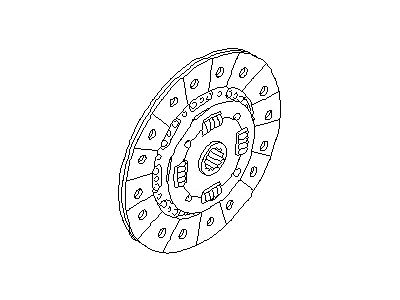×
- Hello
- Login or Register
- Quick Links
- Live Chat
- Track Order
- Parts Availability
- RMA
- Help Center
- Contact Us
- Shop for
- Nissan Parts
- Nissan Accessories

My Garage
My Account
Cart
Genuine Nissan 240SX Clutch Disc
Friction Disc- Select Vehicle by Model
- Select Vehicle by VIN
Select Vehicle by Model
orMake
Model
Year
Select Vehicle by VIN
For the most accurate results, select vehicle by your VIN (Vehicle Identification Number).
7 Clutch Discs found
Nissan 240SX Clutch Disc
If you need any OEM Nissan 240SX Clutch Disc, feel free to choose them out of our huge selection of genuine Nissan 240SX Clutch Disc. All our parts are offered at unbeatable prices and are supported by the manufacturer's warranty. In addition, we offer quick shipping to have your parts delivered to your door step in a matter of days.
Nissan 240SX Clutch Disc Parts Questions & Experts Answers
- Q: How do you determine if you should replace the clutch cover, clutch disc, and pressure plate at the same time on Nissan 240sx?A:Clutch cover and pressure plate are stated to be in balance when considered as assembly thus when either of the part is worn out or damaged both the parts and the release bearing must be replaced. Cracks in the flywheel should also be looked for, and then it should be turned or replaced depending on its condition and the torque applied on the flywheel retaining bolts. Starting from the fact that, with the engine having been installed, the next step is pulling the transmission/transaxle out of the engine fully. Depress the clutch disc hub and place a barring such as clutch aligning bar or similar tool underneath to support it while it is removed. Most of the clutch manufacturers put a match mark on the assembly to ensure that the assembly and flywheel get a correct fit when replaced. Remove the bolts in order starting with the first bolt until all the bolts have been removed then you can remove the pressure plate and clutch disc. The release mechanism of the transmission housing when pulling the shift lever using a set screw, grease the identified contact points with lithium based molybdenum disulfide grease. Remove the release bearing and if worn replace it, and after applying a little grease to the splines of the transmission, place the clutch disc back in the contact and move forward and backward to spread the grease. Scrape off any extra grease, replace the clutch disc on the flywheel through using an alignment tool and put the pressure plate and fasten the bolts in a mix up diagonal order to 16-22ft-lbs. Last, take out the dummy shaft and install the new/reconstructed/repaired/troubleshooted transmission/transaxle, and test the system for its functionality.












